

You are using an out of date browser. It may not display this or other websites correctly.
You should upgrade or use an alternative browser.
You should upgrade or use an alternative browser.
dbltree
Super Moderator
can you spray 24D establishment fall to kill weeds or no ?
Yes...as long as the grasses have 3-4 leaves it's safe to spray 2-4D :way:
Jbohn
Well-Known Member
IS it to late to mow my WSG, to cut weeds back on a establishment stand first year, I havent been out to check on them my neighboir said weeds are 3 feet tall he doesnt see any grasses, wondering should I mow to 12 inches or just let it eat till next spring, he doesnt know what the grasses look like myself included. I think he cant see them because they are lost in the weeds about 6inchs tall.
Last edited:
dbltree
Super Moderator
IS it to late to mow my WSG, to cut weeds back on a establishment stand first year, I havent been out to check on them my neighboir said weeds are 3 feet tall he doesnt see any grasses, wondering should I mow to 12 inches or just let it eat till next spring, he doesnt know what the grasses look like myself included. I think he cant see them because they are lost in the weeds about 6inchs tall.
You can clip them high to give the NWSG seedlings some sunlight but...if the grasses are so tall and think that they will smother the seedlings when mowed it might be better to leave it so you might have to try clipping and see how it goes?
Jbohn
Well-Known Member
I was thinking I have a weed wick just adjusted up high enough to get the weeds above the grasses, what do you think as well should I put round up and 24d in the wick. ? Always fun learning ..Do you think this would be better than mowing the 2nd year as well..
Last edited:
dbltree
Super Moderator
I was thinking I have a weed wick just adjusted up high enough to get the weeds above the grasses, what do you think as well should I put round up and 24d in the wick. ? Always fun learning ..Do you think this would be better than mowing the 2nd year as well..
Not saying it couldn't work but your taking a chance if any natives are taller then you think
spltbrow
Member
Just went and checked my grass tonight. I was pleasantly surprised it is doing pretty good. Probably up to about 50% coverage. I was planning on mowing one more time but I may just hold of and spray after it goes dormant this fall. The deer are already using it and I would like to have some cover there for the season as I have some strips of corn that I also planted in it that are doing really well. All in all pretty happy considering the amount of rain we have not gotten. The corn field next to my nwsg has been chopped already.
dbltree
Super Moderator
November 29th, 2012
I dormant seeded some NWSG last winter and drilled some in the spring for comparison but due to the extreme drought, none of it survived and because I used Plateau for weed control it's pretty clean and obvious that there are no NWSG plants.

Failure is rare when establishing NWSG but so are extreme back to back droughts with ours being the worst since 1956,,,the year I was born, in other words the worst in my lifetime. At any rate I decided to dormant seed it again using my no-till drill and was surprised to find plenty of NWSG seedlings in the one place I least expected it...where I had planted into winter rye!

In past years with heavy rainfall I had an area with severe erosion so I sowed winter rye to hold the soil knowing that due to the allelopathic chemicals in the rye roots I might not get good germination from the NWSG seed. Obviously the rye had no negative effect on the seed as there are NWSG seedings everywhere!

But why? Why did the seedlings survive there and no where else?

The exact same reason we had brassicas where rye was planted and a complete failure where there was no rye! The water retaining, massive rye root systems held water like a sponge and allowed the tiny NWSG seedlings to get started!

No I am not suggesting that everyone run out and plant rye ahead of nwsg because people have had problems with germination

In this case I sprayed the rye just as it was going to seed but that would be considered way to late to have any affect on the allelopathic chemicals

But if you are dealing with dry soils or a high probability of extreme drought it may be worth some experimentation? Try a portion of a field or a small area ad compare the seeding success to areas with no rye and then share the results.

When normal rainfall is expected I would avoid using any cereals ahead of a NWSG planting, RR soybeans are a great way to prepare the area by insuring all sod has been killed and a bare clean soil surface is great for broadcasting or drilling, although killed sod will work very well.
Weather extremes can cause failures of almost any crop planting as well as native grasses and tree seedling, be it from floods or drought but in this case drought also allowed the tremendous soil building attributes of winter rye to shine with glowing results....food for thought when making seed/crop choices for your habitat program....
I dormant seeded some NWSG last winter and drilled some in the spring for comparison but due to the extreme drought, none of it survived and because I used Plateau for weed control it's pretty clean and obvious that there are no NWSG plants.

Failure is rare when establishing NWSG but so are extreme back to back droughts with ours being the worst since 1956,,,the year I was born, in other words the worst in my lifetime. At any rate I decided to dormant seed it again using my no-till drill and was surprised to find plenty of NWSG seedlings in the one place I least expected it...where I had planted into winter rye!

In past years with heavy rainfall I had an area with severe erosion so I sowed winter rye to hold the soil knowing that due to the allelopathic chemicals in the rye roots I might not get good germination from the NWSG seed. Obviously the rye had no negative effect on the seed as there are NWSG seedings everywhere!

But why? Why did the seedlings survive there and no where else?

The exact same reason we had brassicas where rye was planted and a complete failure where there was no rye! The water retaining, massive rye root systems held water like a sponge and allowed the tiny NWSG seedlings to get started!

No I am not suggesting that everyone run out and plant rye ahead of nwsg because people have had problems with germination

In this case I sprayed the rye just as it was going to seed but that would be considered way to late to have any affect on the allelopathic chemicals

But if you are dealing with dry soils or a high probability of extreme drought it may be worth some experimentation? Try a portion of a field or a small area ad compare the seeding success to areas with no rye and then share the results.

When normal rainfall is expected I would avoid using any cereals ahead of a NWSG planting, RR soybeans are a great way to prepare the area by insuring all sod has been killed and a bare clean soil surface is great for broadcasting or drilling, although killed sod will work very well.
Weather extremes can cause failures of almost any crop planting as well as native grasses and tree seedling, be it from floods or drought but in this case drought also allowed the tremendous soil building attributes of winter rye to shine with glowing results....food for thought when making seed/crop choices for your habitat program....
Here, in southwest Kansas, our drought continues. I had pretty good luck with my 150 acres of NWSG this year. Seems like just when I was desperate for rain, I got some. Most areas of my quarter are pretty thick with grass, relatively speaking. Some are pretty thin. I had most of the grass go to seed. Does it spread very good from sort of naturally seeding itself and spreading? I have very sandy ground and I feel lucky that on my corners of my previously irrigated ciricle, there was a lot of sand dropseed that just came up, musta been in the ground for years. It spread pretty fast last year, esp in the worst looking areas of my corners. I wonder if this seed is known to you folks, maybe not, it is predominate in very arid regions I think.
slice and dice
New Member
Dbltree...you also have to wonder if seed to soil contact was improved a little in the areas of higher erosion, if the seed was surface broadcast.
Prairie I planted last winter (surface broadcast on fescue that was sprayed for several rounds and burned) appears to be a failure except for a few plants here and there. Planning on raining more seed on it before the first good snow...although probably at half the rate, just in case more seedlings "come out of dormancy" than expected. Planning on doing nothing with a small section of it, to see what actually comes in for the second year.
Had a lot of Tall or Rough Dropseed volunteer this year in places where nothing has been planted.
Prairie I planted last winter (surface broadcast on fescue that was sprayed for several rounds and burned) appears to be a failure except for a few plants here and there. Planning on raining more seed on it before the first good snow...although probably at half the rate, just in case more seedlings "come out of dormancy" than expected. Planning on doing nothing with a small section of it, to see what actually comes in for the second year.
Had a lot of Tall or Rough Dropseed volunteer this year in places where nothing has been planted.
KSHUNTER
PMA Member
I no-tilled a native mix into bean stubble in early Feb., my mix contains Little Blue, Big Blue, CIR, Indian Grass, and then some forbs. Can I put a light dose of panoramic or plateau say 2oz-4oz an acre and then mix a dose of roundup in?
Just not sure how much I can get away with on the panoramic and not hurt any of the grasses I planted.
Just not sure how much I can get away with on the panoramic and not hurt any of the grasses I planted.
slice and dice
New Member
What weeds are indicating you may have a problem in 2013? Plantings following RR soybeans are usually pretty clean and the #1 method.
Most are annual and can be controlled by 3 or 4 mowings the first year.
Having said that here are my observations for central Iowa to this day:
The warmest our 4 inch soils have been this spring is 48 degrees. No emergence has occurred with diverse new plantings done over the winter for me. Quite a bit of emergence has occurred on 1 year old plantings. I have little bluestem and indiangrass seedlings going into their second year with 1 to 3 inches of green up already. Quite a few forbes are emerged in mixed plantings done January 2012. Some of my mature big bluestem and indiangrass is not emerged yet, yet some has sparse 1 to 2 inch green emergence. If you burned in the fall last year you likely have more emergence now compared to non burned on established plants.
Most are annual and can be controlled by 3 or 4 mowings the first year.
Having said that here are my observations for central Iowa to this day:
The warmest our 4 inch soils have been this spring is 48 degrees. No emergence has occurred with diverse new plantings done over the winter for me. Quite a bit of emergence has occurred on 1 year old plantings. I have little bluestem and indiangrass seedlings going into their second year with 1 to 3 inches of green up already. Quite a few forbes are emerged in mixed plantings done January 2012. Some of my mature big bluestem and indiangrass is not emerged yet, yet some has sparse 1 to 2 inch green emergence. If you burned in the fall last year you likely have more emergence now compared to non burned on established plants.
KSHUNTER
PMA Member
There are some small winter broadleafs starting to show up, and just want the best establishment I can get. It is pretty clean overall though, I think I hit it 3 times last year with RU.
I talked to John at Praire Seed Farms and he said it would be fine at 4oz per acre with Panoramic or Plateau, so that is my plan.
I talked to John at Praire Seed Farms and he said it would be fine at 4oz per acre with Panoramic or Plateau, so that is my plan.
dbltree
Super Moderator
April 19th, 2013
There is a limited time frame each spring when native grass can be burned or sprayed and that time period can be highly variable based on the weather. Warm weather of course speeds up growth of cool season grasses (CSG) but wet weather can prevent either burning or spraying and with nearly 10" of rain in the past few weeks...neither one is possible here!
It's cooler then normal here so natives have zero growth
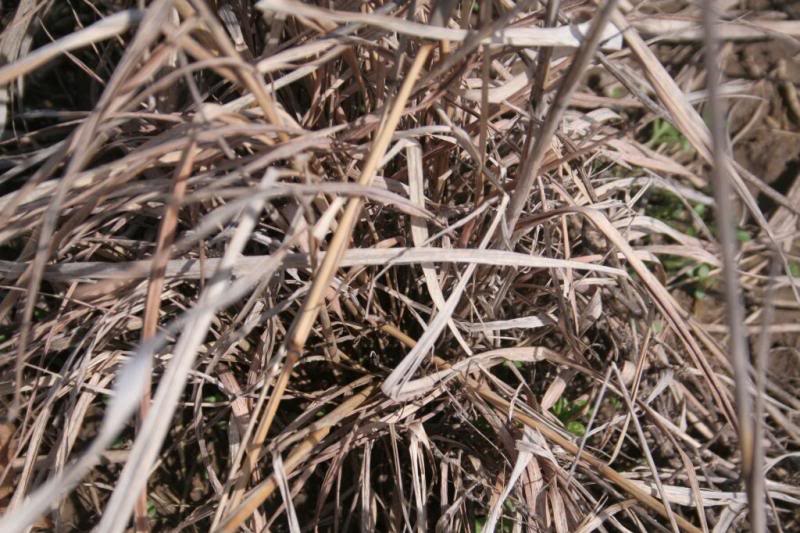
All species are still completely dormant here
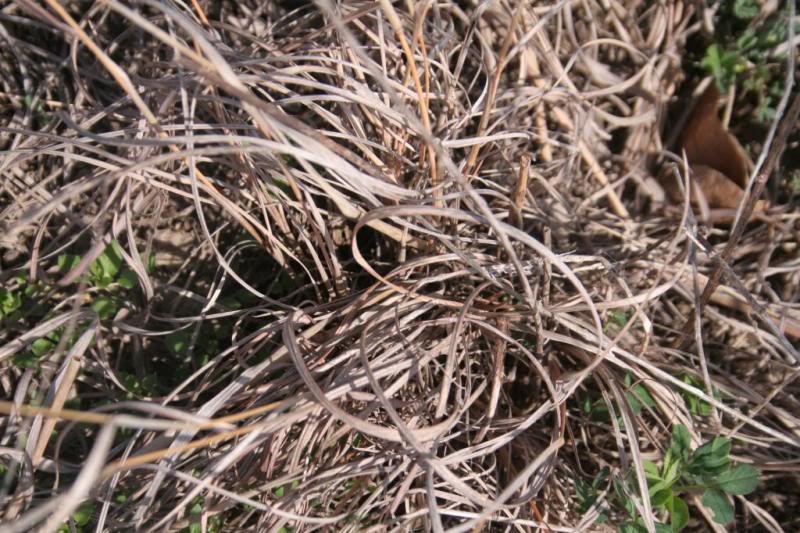
This is a young stand that has endured to years of severe drought and now just beginning it's 3rd growing season
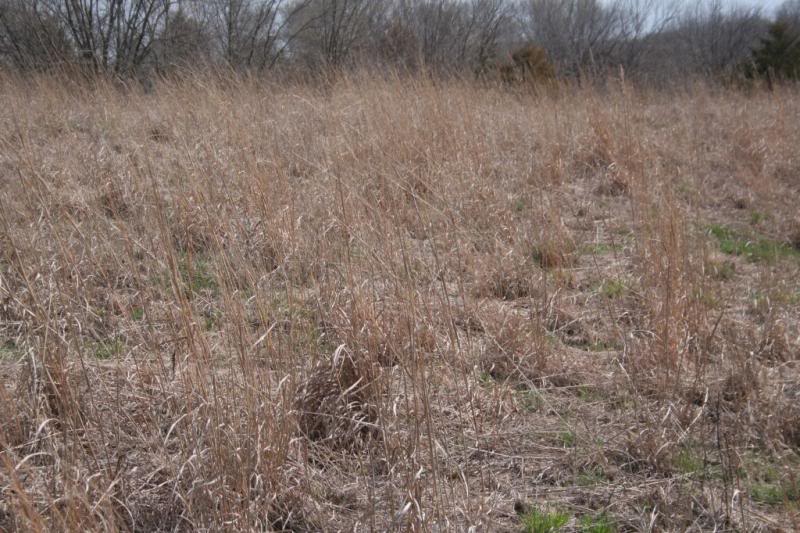
Herbicides could be applied anytime that natives are still dormant
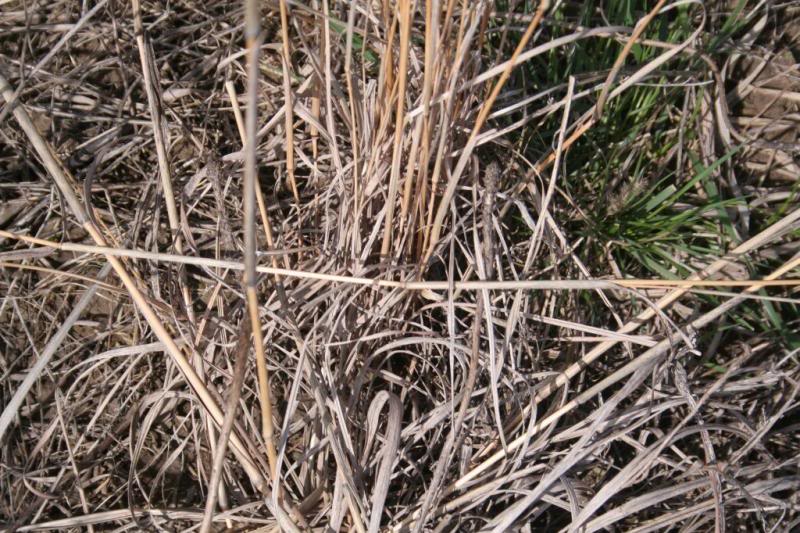
Glyphosate can safely be used to kill CSG before WSG comes to life
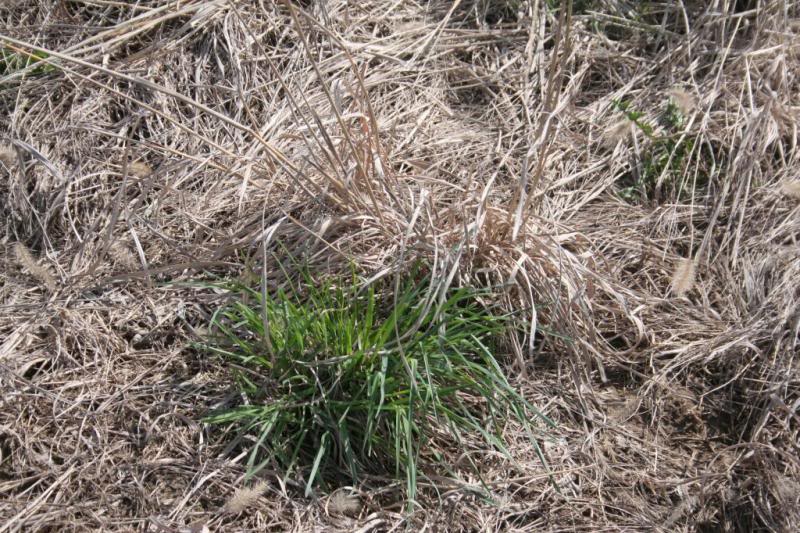
Burning is best done a little later, just before natives start to emerge to set back cool seasons. Burning to early allows the CSG to come back before natives are ready
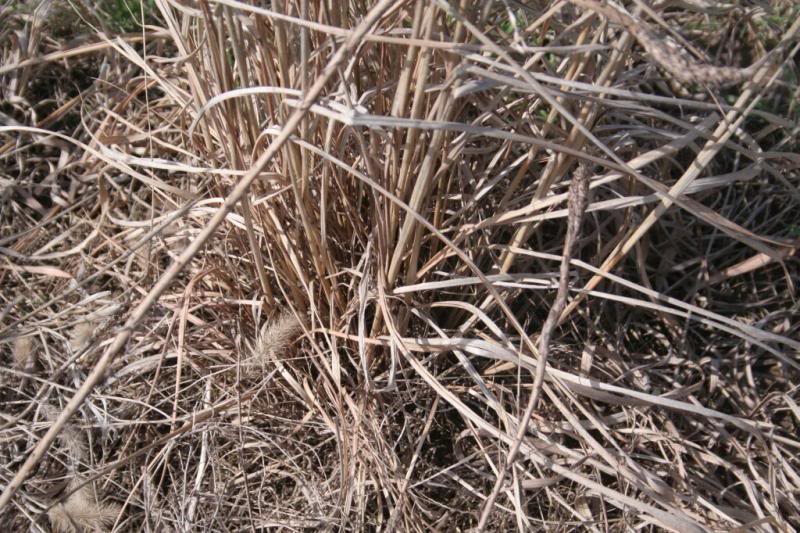
Where only the tallgrasses are involved and are well established (at least to growing seasons) Oust XP(SFM75) can be used at 1-2 ounces per acre along with gly to clean up tough csg like fescue. Plateau is also a great option depending on what forbs are a part of the mix.
NWSG once established has very deep root systems making impervious to many herbicides applied while they are dormant.
Wait to burn until the 3rd year after establishment at which point the stands can be safely burned every spring :way:
There is a limited time frame each spring when native grass can be burned or sprayed and that time period can be highly variable based on the weather. Warm weather of course speeds up growth of cool season grasses (CSG) but wet weather can prevent either burning or spraying and with nearly 10" of rain in the past few weeks...neither one is possible here!
It's cooler then normal here so natives have zero growth

All species are still completely dormant here

This is a young stand that has endured to years of severe drought and now just beginning it's 3rd growing season

Herbicides could be applied anytime that natives are still dormant

Glyphosate can safely be used to kill CSG before WSG comes to life

Burning is best done a little later, just before natives start to emerge to set back cool seasons. Burning to early allows the CSG to come back before natives are ready

Where only the tallgrasses are involved and are well established (at least to growing seasons) Oust XP(SFM75) can be used at 1-2 ounces per acre along with gly to clean up tough csg like fescue. Plateau is also a great option depending on what forbs are a part of the mix.
NWSG once established has very deep root systems making impervious to many herbicides applied while they are dormant.
Wait to burn until the 3rd year after establishment at which point the stands can be safely burned every spring :way:
dbltree
Super Moderator
Paul--Have you used oust on established Little Blue,Big Blue or Indian grass.I no it works great on switch.Thanks.
Yes...worked well, I suggest 2 ounces on established NWSG on heavy clay soils and one ounce on lighter sandy soils.
Here is one of the least expensive sources I know of SFM 75 Herbicide
SFM 75 is a generic version of Oust XP and Spyder
dbltree
Super Moderator
If you have CRP that you seeded during last years drought and the seeding did not survive....consider the following options:
Contact your FSA/NRCS office for more details and to arrange an inspection of fields
CONSERVATION
Failed CRP Practices
Producers are concerned about the effects the drought had on their CRP cover. Below is a brief
outline of some applicable procedure to consider.
If the seeding has truly failed, and is reported by the producer, COC’s can provide c/s to re-
establish the cover per the following procedure:
¶493B C/S for Re-Establishment
If the practice failed because of a natural disaster or through no fault of the participants, COC
shall evaluate the site to determine both of the following:
• the purpose of the practice is being met
• remaining cover provides the same environmental benefits as the original cover, which include
• water quality benefits
• wildlife habitat benefits
• erosion control.
If both criteria are met, COC shall not authorize C/S for re-establishment.
If both criteria are not being met, COC shall determine whether the cost of restoring the approved
cover outweighs the benefits that would be received from the restoration. COC’s shall, at a minimum,
consider all of the following:
• cost of restoring cover
• length of time needed to restore the cover
• benefits received from restored cover
• years remaining before CRP-1 expires
• type of cover to be restored.
If the cost of restoring the approved cover outweighs the benefits that would be received from the
restoration, COC shall terminate CRP-1. – see the text in paragraph’s571A & 575A that follow below.
If the benefits that would be received from the restoration outweigh the cost of restoring the approved
cover, COC shall authorize eligible C/S for:
• re-establishing the approved cover
• temporary cover, if needed
• dead litter crop, if needed.
Note: For land devoted to CP3 or CP3A for which the participant received C/S or an easement
practice, additional C/S shall be authorized.
Contact your FSA/NRCS office for more details and to arrange an inspection of fields